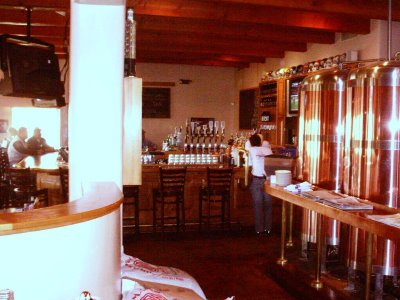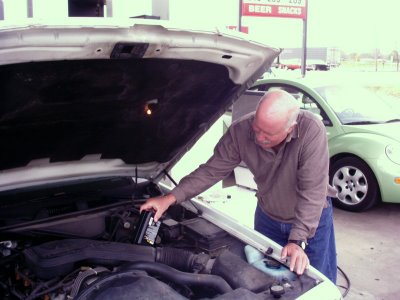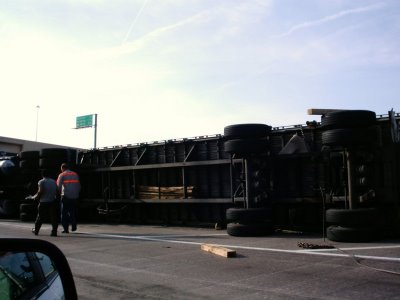My only previous trip to San Francisco and environs was in 1978, and although it was a memorable week, the untutored and inexperienced mind of a teenaged Hoosier obviously could not be expected to fathom the kaleidoscopic opportunities offered by the world famous metropolis.
From the time Graham and I departed Louisville on April 5, 2006, for the cross-country drive that eventually would place us just south of the Bay Area in historic Monterey, we engaged in detailed daily itinerary discussions, the gist of which evolved into a form of travel triage: Given that he had taken the route previously and I had not, my sightseeing whims would be paramount, but more importantly overall, we agreed that if in doubt, more time would be expended in those places, primarily rural or smaller sized, that were less likely to be revisited easily in the future.
For instance, Memphis. A city well worth visiting for its river history, its delectable barbecued ribs and its playoff-bound NBA team, but one that is easily accessible from Louisville – and consequently, one to be saved for another day.
However, stopping along Highway 1 by a California coastline cove, breathing salt air mists, dipping a toe into the swirling tidal pool and having a crisply hopped craft beer for lunch – maybe actual food, and maybe not – is something to indulged, not deferred.
On Sunday night as we polished off the deliciously greasy pub fare at Monterey’s Mucky Duck and washed it down with fresh Sierra Nevada Porter, Graham and I reached a hard decision about the following day’s schedule.
There simply would not be sufficient time to properly enjoy the city of San Francisco. A mere half day there would amount to little more than a brutal teaser, and barely enough time to get proper bearings, enjoy a good meal and find the
Toronado, much less the adequate opportunity to contemplate tourist destinations, cultural attractions and perhaps a baseball game.
Furthermore, I knew that because the annual craft brewers conference was about to convene in Seattle, several people I aimed to meet at breweries located north of San Francisco would likely be out of town if we waited until the middle of the week to drop in and visit them.
And – to be honest – I already could feel the powerful gravitational pull of Rogue Ales even if it were still a few hundred wonderful miles up the Pacific Coast in Newport, Oregon.
With openly acknowledged regrets, we determined to bypass San Francisco this time around with a promise to return and do it right some other day, and with the blessed electronic help of
Mapquest, a relatively quick and painless route via San Jose and Oakland’s Interstate system was plotted, with the stated objective of Santa Rosa and liquid lunch at the renowned
Russian River Brewing Company in a place otherwise recognized as the gateway to California’s wine country.
Mapquest’s directions were letter perfect, and we jetted through the sprawling collection of cities making up the East Bay just after morning rush hour, passing the hallowed shrine (well, to me) of the Oakland Athletics ballpark, noting with surprise that there’s much more to Oakland than Gertrude Stein ever was willing to let on, catching a few welcomed glimpses of downtown San Francisco and the Golden Gate Bridge looming to the west, and finally crossing the water at the San Pablo Bay neck by means of the Richmond-San Rafael Toll Bridge, motoring past an ominous San Quentin Prison and into legendary Marin County.
The friendly doors to Russian River Brewing Company were just opening for business when Graham parked the car at the municipal lot adjoining the rear of the brewpub. We dashed through the rain to a waiting seat at the scantily populated bar.
The first sign I saw explained the notion of a
Lupulin Threshold Shift, and I knew immediately that it was going to be a very good experience.
Soothingly, it would seem that the Noble Cone ranks highly at Russian River, as the brewer and owner, who had already decamped for the Seattle trade show and was unavailable for questions, is credited with originating the Double (or Imperial) IPA style while working at a brewery nearby in 1994.
His creation now is vended at Russian River under the admirably witty name of Pliny the Elder, the Roman scholar who first provided the Latin name for the hop (Humulus lupulus). As luck would have it, it was temporarily absent from the draft lineup on April 10.
No matter. The brewery’s regular IPA is more than suitable as a hoppy replacement, with tingly loads of the sticky, piney hop character one wishes were dominant in all such creations.
The remainder of the beer list at Russian River is extensive and boasts a number of creative and innovative stylistic entries, including an entire line of Belgian-and French- influenced ales that end with the –tion suffix – consciously mimicking the –ator of German Doppelbock, perhaps? Perdition, Damnation, Salvation, Erudition … and coming soon, Deification.
With the help of our enabling bartender, I sampled nips of a few, and all were quite tasty, as was my calzone. It was one of those places you hate to leave, because the quality of the beer and the food is matched by a commitment to intelligence in marketing. For the opposite of these essential beer qualities, look no further than mass-market beer advertisements on television, which market alcohol-laced soda pop by insulting the intelligence of the viewer.
That many viewers are fully deserving of such treatment is a topic for another day (and another IPA).
----
Our drive resumed, crossing west through the hills around Sebastopol and meeting Highway 1 at Bodega Bay. Forty miles of lovely coastline followed, until we stopped for a relevant history break at Fort Ross State Historical Park, where an explanation is forthcoming for the presence of rivers named “Russian” and towns called “Sebastopol” in California, which as we know, the United States forcibly wrested from Mexico -- but not before Fort Ross was constructed with virgin timber felled by seafaring colonists of the Russian empire, who were in search of seal pelt riches.
These riches were elusive. The Russian colony was disbanded after four decades of persistent financial losses, and the property was sold to a Mr. Sutter – of Sutter’s Mill fame. Although parts of the fort and various regional geographical appellations have survived the test of time, the Russians did not leave behind a taste for Kvass, their mildly fermented, lightly carbonated staple concocted from black bread and baker’s yeast … and that’s just as well.
See also:
Three days that shook my world.Yet further up the coast is the sleepy hamlet of Albion, which calls to mind New Albion -- not the Pacific Coast as dubbed by the randy sailor, diligent explorer and all-around wild man Sir Francis Drake, but the brewery, a pioneering endeavor well ahead of its time, founded in Sonoma (near Santa Rosa) in 1976 and certainly the first “microbrewery” of the contemporary age.
It sank in 1982, but some of the equipment and the yeast strain were conveyed to the
Mendocino Brewing Company, which picked up where New Albion left off and survives today inland at the towns of Hopland and Ukiah after several moves and ownership changes. The current moneymen are brewery investors from India, and that’s not a problem so long as Kingfisher is kept safely out of the equation.
Anderson Valley Brewing Company is located nearby, too (in Boonville), and then there’s
North Coast Brewing Company, dating from 1988 and a bona fide classic microbrewer that has persevered to become a major “manufacturing” component of the evolving local economy of its hometown, our Monday destination of Fort Bragg, California.
----
Fort Bragg, a town of 7,000, traditionally has been referred to as a “blue-collar” kind of place, a working town in contrast with the artist and tourist colony at Mendocino nearby.
A huge Georgia-Pacific complex testifies to the importance of the lumber and wood products industry, but it is now mothballed, and the spacious site awaits redevelopment. Today, the town continues down the increasingly common path of
transition to tourism and recreation, centered on regional attractions like the Pacific Ocean, the Shasta Mountains to the east, and the Redwood preserves to the north.
The maker of Red Seal Ale, Old Rasputin Imperial Stout, PranQster Belgian Golden, Scrimshaw Pilsner and the Acme brands, among others, North Coast enjoys widespread respect among craft beer aficionados, and with the brewery’s beers available in Indiana for many years, a loyal following far away from the home base is a vital part of the company’s business plan.
However, getting the beer from Fort Bragg to drinkers worldwide can be somewhat of a bottleneck, as Senior Vice President Doug Moody explained during our orientation tour on Tuesday morning.
The brewery has ever-increasing opportunities to do just this, but these aims are hampered by Fort Bragg’s physical isolation on the coast. Interstate 5 is more than 100 air miles from the town and far longer by winding mountain roads, and although these same roads provide access to the far closer US 101, the same roadway restrictions on tractor-trailer length apply.
The brewery is in the process of negotiating a clever deal with a regional restaurant supply business to ship out beer in the emptied (and properly sized) food trucks heading back south toward the Bay Area, where a North Coast warehouse will be established and stocked to assist the exporting of North Coast beer.
Meanwhile, conveying beer to the taproom and restaurant located across from the brewery on Fort Bragg’s main street might be as simple as rolling out the barrels between passing RV convoys, but as we learned from Doug on Monday afternoon after entering town, the pub and eatery are closed on Monday and Tuesday during the off season. He helpfully suggested that we try
The Wharf, situated down the bluff from the highway by the town’s smallish Noyo Harbor, for North Coast beers on tap and top-notch food.
Judged by the relaxing and salutary effect of a grilled local-catch seafood combo and smooth pints of Scrimshaw and Rasputin, he was right on both counts.
On Tuesday morning, following a hearty breakfast and rich black coffee at a funky organic/free range café adjacent to the motel, we proceeded to the brewery and learned about North Coast’s fascinating history.
According to Doug, North Coast’s founder and brewer Mark Ruedrich has followed a brewing philosophy of seeking to avoid the yeast-accented “house character” of many (probably most) microbrew product lines, preferring instead to showcase the malt and hops appropriate for a given style.
For the brewery’s latest new product,
Brother Thelonious Belgian Style Abbey Ale, a sense of improvisational proportion would lead one to expect the stray yeasty ester.
Brother Thelonious, an homage to the jazz great Thelonious Monk, and created in conjunction with his Institute of Jazz, is just being released in selected markets and should seep into Indiana later in 2006. Doug gifted Graham and I with short-fill bottles, which we’ll sample once Graham is back in town.
Doug’s comments about the brewery operation were interspersed with observations on the gentrification of Fort Bragg. As the town has become a vacation destination, property values predictably have risen, with the result that it has become increasingly difficult to hire good people owing to the higher cost of living. His passion on this and other topics spoke to the desire on the part of most successful microbrewers to instill a sense of family and shared purpose over and above financial solvency and growth.
One way to achieve the latter without sacrificing the former is diversification. Last year, combined sales of North Coast’s bricks-and-mortar brewery shop and its on-line counterpart reached a million dollars, and this isn’t just tons of Red Seal ball caps going out the door.
It’s a stamp of approval from beer lovers, who are more than willing to return the favor in loyalty when beer quality and company character are prime components of the business plan.
It’s something to strive for – for sure.



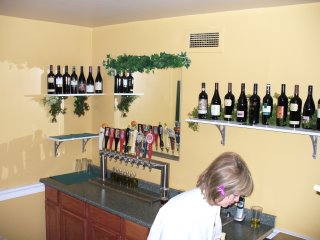
 Gratifyingly, the common theme of conversations held during the course of the evening was optimism for New Albany’s future. I’ve always been aware that for some in the community, the advent of a dining and drinking establishment is not something to be regarded as a signal accomplishment, but for those already living and working downtown – whether their tenure is measured in months, years or decades – and for those everywhere in New Albany willing and able to learn and speak what amounts to a second language hereabouts – this being the language of progress, success and future thinking – the arrival of bNA and other bastions to follow preface a turning point.
Gratifyingly, the common theme of conversations held during the course of the evening was optimism for New Albany’s future. I’ve always been aware that for some in the community, the advent of a dining and drinking establishment is not something to be regarded as a signal accomplishment, but for those already living and working downtown – whether their tenure is measured in months, years or decades – and for those everywhere in New Albany willing and able to learn and speak what amounts to a second language hereabouts – this being the language of progress, success and future thinking – the arrival of bNA and other bastions to follow preface a turning point.

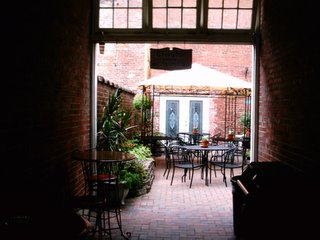
 Pyramid’s claim to craft beer fame is its infuriating Hefe Weizen, which borrows two-thirds of the Bavarian wheat ale formula – it’s unfiltered and made with wheat – but backs away from the classic style where it means the most, using non-specialized American ale yeast for fermentation, thus sacrificing the fruity/spicy flavors and aromas that characterize the genuine article.
Pyramid’s claim to craft beer fame is its infuriating Hefe Weizen, which borrows two-thirds of the Bavarian wheat ale formula – it’s unfiltered and made with wheat – but backs away from the classic style where it means the most, using non-specialized American ale yeast for fermentation, thus sacrificing the fruity/spicy flavors and aromas that characterize the genuine article. Upper deck seats on the east (right field) side of Safeco provide views of both the Olympic Mountains and the ferries and commercial ships going back and forth, in, out and across Puget Sound.
Upper deck seats on the east (right field) side of Safeco provide views of both the Olympic Mountains and the ferries and commercial ships going back and forth, in, out and across Puget Sound.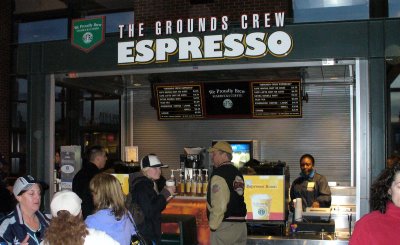 When it comes to food at Safeco Field, fans can choose from items like barbecued pork and the fixings, Tex-Mex munchies, full Thai platters and a half dozen varied presentations of sushi (with sake-from-a-box to accompany). These are the eateries I personally witnessed along the field level concourse; there may be others elsewhere.
When it comes to food at Safeco Field, fans can choose from items like barbecued pork and the fixings, Tex-Mex munchies, full Thai platters and a half dozen varied presentations of sushi (with sake-from-a-box to accompany). These are the eateries I personally witnessed along the field level concourse; there may be others elsewhere.  Sushi and India Pale Ale at a baseball game in Seattle? I couldn’t resist the pairing.
Sushi and India Pale Ale at a baseball game in Seattle? I couldn’t resist the pairing.  What could be more appropriate given the city’s maritime heritage, its multicultural ethos, the contemporary setting on the Pacific Rim facing the vibrant Asian economies – not to mention the fact that outfielder Ichiro’s status as a bona fide Mariners hero fully incorporates his resume as Japanese baseball legend?
What could be more appropriate given the city’s maritime heritage, its multicultural ethos, the contemporary setting on the Pacific Rim facing the vibrant Asian economies – not to mention the fact that outfielder Ichiro’s status as a bona fide Mariners hero fully incorporates his resume as Japanese baseball legend?  Kids (and adults) dissatisfied with Ichiro’s on-field performance can try to do better at one of the Nintendo game stations for public use, which are located near the children’s play area beyond the centerfield bleacher seats.
Kids (and adults) dissatisfied with Ichiro’s on-field performance can try to do better at one of the Nintendo game stations for public use, which are located near the children’s play area beyond the centerfield bleacher seats. To be honest, I’m not sure what variety of sushi I consumed, although I was pleased to read a “raw food” health warning on the plastic package. Whatever it was, I’ve had better at Maido Essential Japanese. But that’s hardly the point.
To be honest, I’m not sure what variety of sushi I consumed, although I was pleased to read a “raw food” health warning on the plastic package. Whatever it was, I’ve had better at Maido Essential Japanese. But that’s hardly the point.
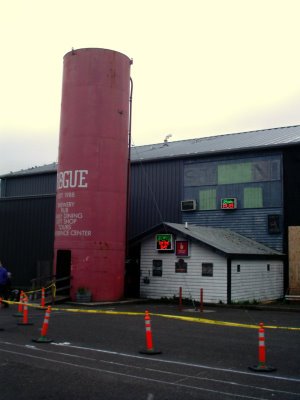
 Where to begin? Great folks, numerous varieties of distinctive beer, drinking establishments on both sides of the harbor, wearables and gear, a new and growing distillation operation (Northwestern botanicals in a gin, for example, and also a craft vodka), oyster shooters and Kobe beef burgers, more great folks ... the list goes on and on.
Where to begin? Great folks, numerous varieties of distinctive beer, drinking establishments on both sides of the harbor, wearables and gear, a new and growing distillation operation (Northwestern botanicals in a gin, for example, and also a craft vodka), oyster shooters and Kobe beef burgers, more great folks ... the list goes on and on.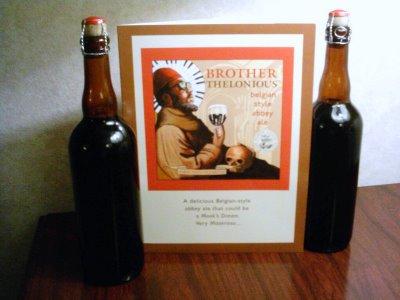




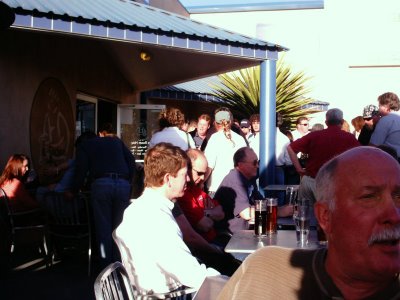
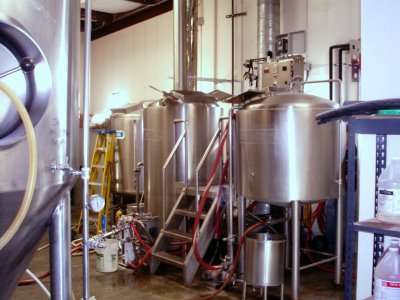 Beer scribe and resident Stan Hieronymus met us at the tap room, and he introduced Brady, Il Vicino's brewer, who found time while working to pour samples of some upcoming seasonals brewed with Belgian yeast. Soon our friend Steve Bohannon arrived, and after that his girlfriend Caroline, and we embarked on a journey to Central Avenue. If you've been to Bardstown Road in Louisville, then you have an idea of Central in Albuquerque. It's near the campus of the University of New Mexico, and was filled to the brim with youthful revelers.
Beer scribe and resident Stan Hieronymus met us at the tap room, and he introduced Brady, Il Vicino's brewer, who found time while working to pour samples of some upcoming seasonals brewed with Belgian yeast. Soon our friend Steve Bohannon arrived, and after that his girlfriend Caroline, and we embarked on a journey to Central Avenue. If you've been to Bardstown Road in Louisville, then you have an idea of Central in Albuquerque. It's near the campus of the University of New Mexico, and was filled to the brim with youthful revelers.
